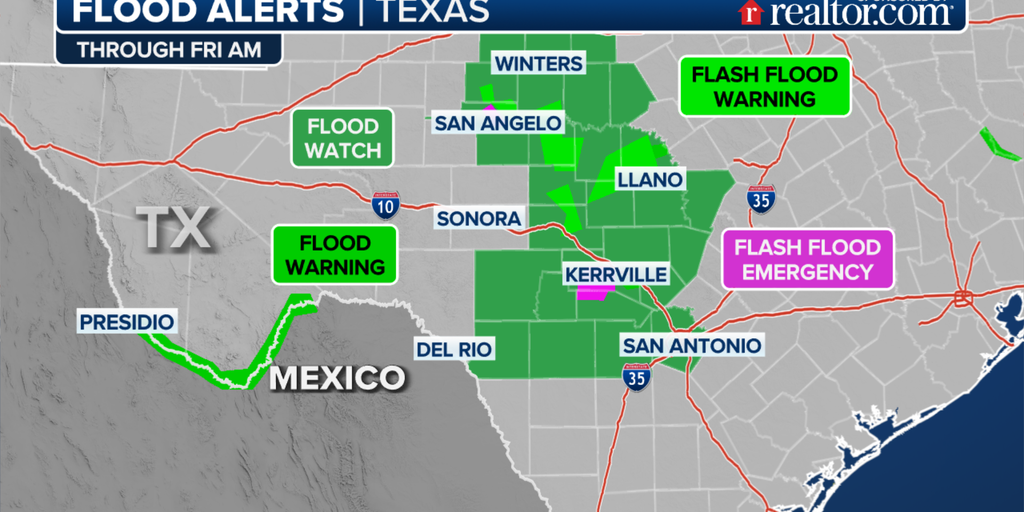Heavy Rains Ignite Flash Flood Emergencies in South Central Texas
Under a slate-grey sky, citizens of South Central Texas awoke to a relentless downpour on Friday, their lives upended as nature unleashed its fury. In the early hours, reports began to flood in of homes engulfed by water, and emergency services were strained as they rushed to respond to numerous rescue calls. As the rains persisted, two Flash Flood Emergencies were declared, marking a profound reminder of nature’s unpredictability and the urgency of preparedness in the face of increasingly volatile weather patterns.
A Torrential Deluge
The FOX Forecast Center first sounded the alarm near San Angelo, where an unprecedented 12 to 15 inches of rain fell within hours, leading to widespread flooding. Just a short drive away in Kerr County, the Guadalupe River swelled alarmingly after more than 7 inches fell in a mere six hours. Homeowners in Brady watched helplessly as water breached their properties, prompting a flurry of emergency efforts. “I’ve never seen anything like this,” said local resident Clara Rodriguez, whose basement filled with water in a matter of minutes. “We had to evacuate in the middle of the night, and all we could do was watch.”
Weather Dynamics at Play
Scientists attribute such extreme weather phenomena to a confluence of atmospheric conditions, namely a stationary front that has settled over the region, combined with an upper-level disturbance migrating from the Four Corners area. This potent mix fuels not only rain but also the potential for severe thunderstorms.
“The impact of climate change has made these types of weather events more frequent and intense,” explains Dr. Samuel Graves, a senior climatologist at the Texas Climate Institute. “Data shows that average rainfall in Texas has increased by approximately 10% over the last century, and this is expected to continue. The events we see today may become the norm if climate trends persist.”
Human Costs of Flooding
As rescue missions unfolded across the flooded areas, the human cost of such weather became painfully evident. In addition to property damage, the emotional toll on communities is severe. Families took shelter in local churches and schools as they awaited news of resettlement and assistance.
- Displacement: Hundreds of families are temporarily displaced, a devastating outcome for many who lack resources for quick recovery.
- Property Damage: Homes and businesses are now rendered uninhabitable, resulting in substantial economic losses projected to be in the millions.
- Increased Emergency Response: Local emergency services have mobilized all available personnel, highlighting the strain on resources during such crises.
Future Preparations
In response to this latest emergency, local governments are calling for enhanced infrastructural investments and improved drainage systems. Historical weather patterns provide a strong case for proactively adapting urban planning strategies. “Investing in better drainage and stormwater management can save lives and reduce economic impacts in the long run,” says Dr. Hana Lee, an environmental engineer at Texas A&M University. “We must learn from these events, not only to respond better but also to mitigate future risks.”
A Broader Problem
The turmoil of South Central Texas is not an isolated instance. Reports of flash floods are emerging from New Mexico as well, indicating a wider geographic pattern attributable to the same meteorological conditions. There, precipitation levels are expected to rise significantly, raising the alarm in similar communities.
The National Weather Service has issued warnings spanning many states, advising residents to stay alert as the weather system continues to evolve. Additional flooding concerns are projected across West Texas and the Southern Rockies of Colorado, underscoring the necessity of interconnected response strategies across state boundaries.
“We are facing unprecedented challenges with our climate,” warns Dr. Luis Arceneaux, a meteorologist involved in regional weather-impact studies. “What happens in one state can drastically affect neighboring regions. As a nation, we must adopt a collective strategy to confront the reality of our changing climate.”
As the skies began to clear late Friday, the enduring struggle for recovery was just beginning. Local residents gathered in their neighborhoods to assess damages and discuss future preventative measures. It’s a sobering reminder that extreme weather events are becoming the new normal, and in their wake lies the need for resilience and renewed commitment to environmental adaptability.









